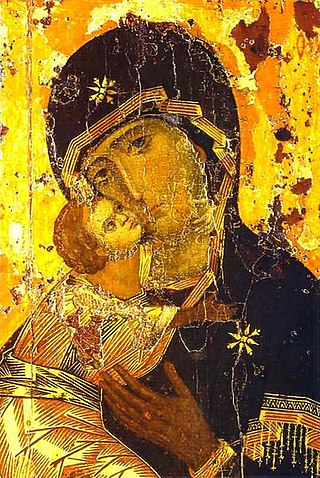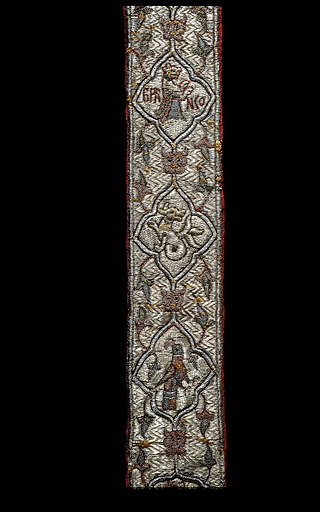
The Hilandar Monastery is one of the twenty Eastern Orthodox monasteries in Mount Athos in Greece and the only Serbian Orthodox monastery there.
The Hilandar Research Library (HRL), located in the Thompson Library on the campus of Ohio State University, has the largest collection of medieval Slavic manuscripts on microform in the world.

A Theotokion is a hymn to Mary the Theotokos, which is read or chanted during the canonical hours and Divine Liturgy of the Eastern Orthodox and Eastern Catholic churches, as well as in the praises of the Oriental Orthodox churches.

Miroslav Gospel is a 362-page Serbian illuminated manuscript Gospel Book on parchment with very rich decorations. It is one of the oldest surviving documents written in the Serbian recension of Church Slavonic. The gospel is considered a masterpiece of illustration and calligraphy.

The Mesić Monastery is a Serb Orthodox monastery situated in the Banat region, in the province of Vojvodina, Serbia. The monastery is situated near the village of Mesić, in the Vršac municipality. It was founded in the 15th century, although legend holds that it was built in 1225 by Arsenije Bogdanović of the Hilandar.

Nikodim I of Peć and Nikodim of Hilandar was a monk-scribe at Hilandar before becoming the 10th Serbian Archbishop from 1316 to 1324, he died in the year 1325. He is a Serbian saint and the Eastern Orthodox Church celebrates his feast day on May 11/24. Nikodim is the author of Rodoslov: srpskih kraljeva i vladika.

Rostuše is a village and seat of the municipality of Mavrovo i Rostuše, North Macedonia.
Joanikije I was the fifth Archbishop of Serbs, serving from 1272 to 1276. He succeeded Danilo I and was succeeded by Jevstatije I.

Jevstatije I was the sixth Serbian Archbishop, holding the office from 1279 to 1286. He was born in the Budimlje parish, near Berane in Zeta. He took his monastics vows in Zeta, then left for the Hilandar monastery to study and meditate and, where he later became the hegumen (abbot), succeeding Joanikije, holding the office 1162–65. He left the monastery and became the Bishop of Zeta, and later the Serbian Archbishop in 1279, succeeding Joanikije I. He died on 4 January 1286. His relics were buried in the Monastery of Peć in 1289-1290, after being transferred from the ruined Žiča monastery. The Serbian Orthodox Church commemorates him on 4 January according to the Julian calendar, or 17 January according to the Gregorian calendar.

Bogorodica Trojeručica or simply Trojeručica is an Eastern Orthodox wonderworking icon believed to have been produced in the 8th century in Palestine by John of Damascus. It depicts Theotokos with young Jesus in the hodegetria position, and is covered with a riza. On the back of the icon is the painting of St Nicholas. It is today found in the Hilandar Monastery on Mount Athos, Greece, and is the most important icon of the Serbian Orthodox Church.

Trebište, Trebishte, or Trebišta is a village in North Macedonia in Mavrovo and Rostuša Municipality, situated in the Dolna Reka district, on the eastern slopes of Dešat, above the gorge of Radika.
Dorotej or Dorotheus was a Serbian Orthodox abbot of Hilandar and the protos of Mount Athos from 1356 until 1366. He is noted for writing a charter for the monastery of Drenča in 1382.
Nikola Stanjević Gospel is an illuminated manuscript Gospel Book in Old Serbian (Rascian). It was donated to the Hilandar monastery of Mount Athos by Serbian Imperial Military commander Nikola Stanjević of Northern Macedonia. The decorations of the manuscript show a diversity of styles which makes this manuscript special. Its author is a monk by the name of Feoktist.
Saint Sava III was the Archbishop of Serbs from 1309 to 1316. Upon completing his studies, he began as a hegumen in Hilandar, then became the Bishop of Prizren. During his office as bishop, he worked on the Bogorodica Ljeviška church in Prizren. In 1309 he became the Archbishop. Sava III was an important figure of the development of architecture in Medieval Serbia. Prior to the founding of the Banjska monastery, which Sava III did not survive, King Stefan Milutin consulted with him. In his charters confirming the endowments of King Milutin, he is styled "Archbishop of All Serbian and Maritime Lands". He rebuilt the Church of Saint George in Staro Nagoričane. According to the testimonies of his successor Archbishop Nikodim I, he regularly donated to Hilandar. The Serbian Orthodox Church venerate him as Saint Sava III on July 26.

Saint Sava, known as the Enlightener, was a Serbian prince and Orthodox monk, the first Archbishop of the autocephalous Serbian Church, the founder of Serbian law, and a diplomat. Sava, born as Rastko Nemanjić, was the youngest son of Serbian Grand Prince Stefan Nemanja, and ruled the appanage of Zachlumia briefly in 1190–92. He then left for Mount Athos, where he became a monk with the name Sava (Sabbas). At Athos he established the monastery of Hilandar, which became one of the most important cultural and religious centres of the Serbian people. In 1219 the Patriarchate exiled in Nicea recognized him as the first Serbian Archbishop, and in the same year he authored the oldest known constitution of Serbia, the Zakonopravilo nomocanon, thus securing full religious and political independence. Sava is regarded as the founder of Serbian medieval literature.
Nikola Stanjević was a magnate who served Emperor Stefan Dušan as veliki vojvoda (general), and who was still alive during the rule of Emperor Uroš V, when in 1366 the Emperor confirmed the metochion of his endowment, the Konče Church, dedicated to St. Stephen, near Radovište, to the Hilandar monastery. He held a province in northern Macedonia, around Skopje. He is an ancestor of Nikola Pavlović "Gefalija" and the Stanjević brotherhood in Montenegro. He is the founder of the Stanjevići Monastery on the southern slopes of Mount Lovćen, overlooking Budva.
Hardomil was a Serbian nobleman that served king Stefan Milutin, with the title of tepčija. He was mentioned as deceased in 1327, in a litigation between his sons' estates and Hilandar. His sons inherited notable land property, which evidents his social status and property state, but not his jurisdiction. The judgement established that his sons, Dmitar and Borislav, had unlawfully used Hilandar's property, and thus the property was returned to Hilandar. Hardomil was succeeded by Vladoje, who served king Stefan Dečanski as tepčija. The Serbian court hierarchy at that time was as follows: stavilac, čelnik, kaznac, tepčija and vojvoda, the supreme title.

Branko was a Serbian magnate who served to king and emperor Stefan Dušan, and emperor Stefan Uroš V, with the titles of sluga and later sevastokrator. A member of an old and respectable family, possibly descending from the Serbian dynasty itself, Branko began his royal service in the nearest circle of the ruler. After the elevation of the Serbian state to the Empire (1346), Branko received the second-highest court title, sevastokrator, usually given to relatives. He governed the Ohrid region. Branko had three sons and a daughter, of whom Vuk Branković would become an important person in the period of the Fall of the Serbian Empire.

Dzerzhinsky (Дзержинский) was one of eight Fidonisy-class destroyers built for the Imperial Russian Navy during World War I. She was originally named Kaliakria (Калиакрия) before she was renamed Dzerzhinsky in 1926.












